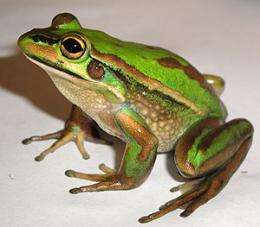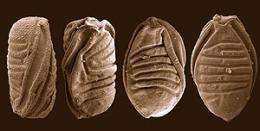A Green and Golden Bell Frog, one of the species affected by this parasite.
(PhysOrg.com) -- University of Sydney researchers have identified two new parasite species causing disease among endangered Australian frogs. They say they are most likely native, overturning a commonly held view they were introduced with cane toads in 1935.
The parasites have so far been found in 10 frog species, including the iconic Green and Golden Bell Frog, the Southern Bell Frog and even the Yellow Spotted Bell Frog - a species presumed extinct for 30 years until recently.
These singled-celled myxosporean parasites have been identified in bell frog populations since 1997, says Ashlie Hartigan, a PhD student leading the research with Dr. Jan Šlapeta from the Faculty of Veterinary Science, David Phalen, Director of the University of Sydney's Wildlife Health and Conservation Center, and Karrie Rose from the Australian Registry of Wildlife Health.
"Infected frogs lose weight, are lethargic, and some can't move their back legs, making them more vulnerable to predators," Hartigan says. "Infection could also be reducing the number of tadpoles that become adults, with affected tadpoles more likely to delay metamorphosis and die from liver disease."
The singled-celled myxosporean parasites under an electron microscope.
When Hartigan and colleagues genotyped parasites from frogs and cane toads collected in New South Wales and Queensland and compared them to myxosporea from South American cane toads, they found that the Australian parasites were distinct from the South American species. This debunks the theory the parasites came to Australia with cane toads.
"We are 99 percent sure the cane toad did not bring it in," says Hartigan, whose research was recently published in a leading science journal PLoS ONE.
But the cane toad is not completely off the hook. "Our data suggests these parasites recently spread across eastern Australia from their original source," Hartigan said. "While the spread may have occurred by a number of means, it is possible that by infecting the invasive Cane Toad the parasite has spread faster and further as a result."
Hartigan says frogs are under increasing threat of disease, and global losses can be attributed to different pathogens. Frogs are bio-indicator species, she says: "The presence of frogs in a habitat indicates good environmental health."
"If we can learn more about the life cycle of these parasites, how they are spread, and identify other potential hosts, we will be able to screen frogs for infection and control the spread to captive breeding populations and threatened populations in the wild."
More information: www.plosone.org/article/info%3Adoi%2F10.1371%2Fjournal.pone.0018871
Provided by University of Sydney





















